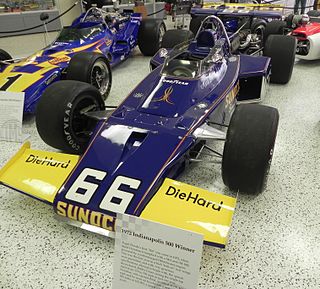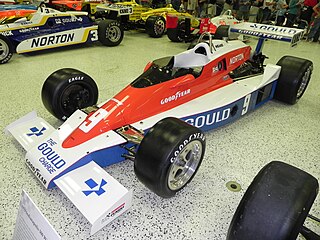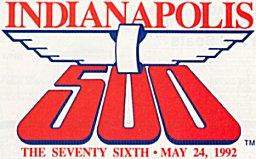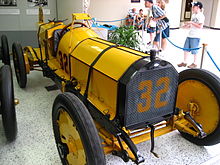
The Indianapolis 500, formally known as the Indianapolis 500-Mile Race, and commonly called the Indy 500, is an annual automobile race held at Indianapolis Motor Speedway (IMS) in Speedway, Indiana, United States, an enclave suburb of Indianapolis. The event is traditionally held over Memorial Day weekend, usually the last weekend of May. It is contested as part of the IndyCar Series, the top level of American open-wheel car racing, a formula colloquially known as "Indy car racing". The track itself is nicknamed the "Brickyard", as the racing surface was paved in brick in the fall of 1909. One yard of brick remains exposed at the start/finish line. The event, billed as The Greatest Spectacle in Racing, is considered part of the Triple Crown of Motorsport along with the 24 Hours of Le Mans and the Monaco Grand Prix, with which it typically shares a date.

The Indianapolis Motor Speedway is a motor racing circuit located in Speedway, Indiana, an enclave suburb of Indianapolis, Indiana. It is the home of the Indianapolis 500 and the Brickyard 400 and formerly the home of the United States Grand Prix and Indianapolis motorcycle Grand Prix. It is located six miles (9.7 km) west of Downtown Indianapolis.

Anthony Joseph Foyt Jr. is an American former racing driver who competed in numerous disciplines of motorsport. He is best known for his open wheel racing career, and for becoming the first four-time winner of the Indianapolis 500. He holds the most American National Championship titles in history, winning seven.

Robert William Unser was an American automobile racer. At his induction into the Motorsports Hall of Fame of America in 1994, he had the fourth most IndyCar Series wins at 35. Unser won the 1968 and 1974 United States Automobile Club (USAC) national championships. He won the Pikes Peak International Hill Climb overall title 10 times.

Rodger Morris Ward was an American racing driver best known for his open-wheel career. He is generally regarded as one of the finest drivers of his generation, and is best known for winning two National Championships, and two Indianapolis 500s, both in 1959 and 1962. He also won the AAA National Stock Car Championship in 1951.

Rufus Parnell "Parnelli" Jones is an American former professional racing driver and racing team owner. He is notable for his accomplishments while competing in the Indianapolis 500 and the Baja 1000 desert race, and the Trans-Am Championship series. In 1962, he became the first driver to qualify over 150 mph. He won the race in 1963, then famously broke down while leading the 1967 race with three laps to go in a turbine car. During his career as an owner, he won the Indy 500 in 1970–1971 with driver Al Unser.

The 54th 500 Mile International Sweepstakes was held at the Indianapolis Motor Speedway in Speedway, Indiana on Saturday, May 30, 1970.

The 56th 500 Mile International Sweepstakes was held at the Indianapolis Motor Speedway in Speedway, Indiana, on Saturday, May 27, 1972. The race is notable in that for the first time, the cars were permitted bolt-on wings, and speeds climbed dramatically. Bobby Unser won the pole position at a then-remarkable speed of 195.940 mph (315.3 km/h) for four laps, breaking Peter Revson's track record of 178.696 mph (287.6 km/h) from 1971 by 17.244 mph (27.8 km/h) – the largest one-year track record increase in Indy history. The race average speed of 162.962 mph (262.3 km/h) was also a new record, which stood until 1984.

The 60th 500 Mile International Sweepstakes was held at the Indianapolis Motor Speedway in Speedway, Indiana on Sunday, May 30, 1976. Polesitter Johnny Rutherford took the lead on lap 80, and was leading when rain halted the race on lap 103. Two hours later, the race was about to be resumed, but rain fell again. USAC officials called the race at that point, reverted the scoring back to the completion of lap 102, and Johnny Rutherford was declared the winner. Rutherford famously walked to Victory Lane, his second career Indy 500 triumph, having completed only 255 miles (410 km), the shortest official race on record. Janet Guthrie became the first female driver to enter the Indianapolis 500. However, her team was underfunded, and she experienced numerous mechanical and engine problems during the month. While she managed to pass her rookie test, and ran numerous practice laps in multiple cars, she was unable to make an attempt to qualify. She would return with a successful effort a year later in 1977.

The 61st 500 Mile International Sweepstakes was held at the Indianapolis Motor Speedway in Speedway, Indiana on Sunday, May 29, 1977. Considered one of the most historically significant editions of the Indianapolis 500, several sidebar stories complemented the unprecedented accomplishment of race winner A. J. Foyt. Foyt became the first driver to win the Indianapolis 500 four times. As of 2023, Foyt's record has been tied by Al Unser Sr., Rick Mears and Hélio Castroneves, but still stands as an Indy 500 record. Foyt's victory is also the last time the winning car was built entirely within the United States.

The 62nd 500 Mile International Sweepstakes was held at the Indianapolis Motor Speedway in Speedway, Indiana on Sunday, May 28, 1978. Danny Ongais dominated the early stages of the race but eventually dropped out with a blown engine. Al Unser Sr. dominated the second half, and held a large lead late in the race. However, Unser bent the front wing of his Lola during a pit stop on lap 180, causing his handling to go away over the final twenty laps. Second place Tom Sneva charged to catch Unser's crippled Lola but came up 8 seconds short at the finish line – the second-closest finish in Indy history to that point. Unser held off the challenge, and became a three-time winner of the 500. It was Al Unser's third Indy victory in the decade of the 1970s, and the fifth of nine overall victories by the Unser family.

The 63rd 500 Mile International Sweepstakes was held at the Indianapolis Motor Speedway in Speedway, Indiana, on Sunday May 27, 1979. Second-year driver Rick Mears took the lead for the final time with 18 laps to go, and won his first of four Indianapolis 500 races. It was also Mears' first of a record six Indy 500 pole positions. Brothers Al and Bobby Unser combined to lead 174 of the 200 laps, but Al dropped out around the midpoint, and Bobby slipped to 5th place at the finish nursing mechanical issues. It was also Roger Penske's second Indy 500 victory as a car owner.

The 53rd International 500 Mile Sweepstakes was an auto race held at the Indianapolis Motor Speedway in Speedway, Indiana on Friday, May 30, 1969. It was the third round of the 1969 USAC Championship Car season. Polesitter A. J. Foyt led the race in the early stages, looking to become the first four-time winner of the 500. Near the halfway point, however, a lengthy pit stop to repair a broken manifold put him many laps down. Despite a hard-charging run towards the end, he wound up managing only an eighth-place finish, 19 laps down. Lloyd Ruby, a driver with a hard-luck reputation at the Speedway, was leading the race just after the midpoint. During a pit stop, he pulled away with the fueling hose still attached, ripped a hole in the fuel tank, and was out of the race. The incident put Mario Andretti in the lead for rest of the way.

The 50th International 500-Mile Sweepstakes was held at the Indianapolis Motor Speedway in Speedway, Indiana on Monday, May 30, 1966. The official program cover for the race celebrated both the 50th running of the race, and 150th anniversary of Indiana statehood.

The 78th Indianapolis 500 was held at the Indianapolis Motor Speedway in Speedway, Indiana on Sunday, May 29, 1994. The race was sanctioned by United States Auto Club (USAC), and was included as race number 4 of 16 of the 1994 PPG IndyCar World Series. For the second year in a row, weather was nary a factor during the month. Only one practice day was lost to rain, and pole day was only partially halted due to scattered showers. Warm, sunny skies greeted race day.

The 76th Indianapolis 500 was held at the Indianapolis Motor Speedway in Speedway, Indiana, on Sunday, May 24, 1992. The race is famous for the fierce battle in the closing laps, as race winner Al Unser Jr. held off second place Scott Goodyear for the victory by 0.043 seconds, the closest finish in Indy history. Unser Jr. became the first second-generation driver to win the Indy 500, following in the footsteps of his father Al Unser Sr. He also became the third member of the famous Unser family to win the race.

The 75th Indianapolis 500 was held at the Indianapolis Motor Speedway in Speedway, Indiana, on Sunday, May 26, 1991. Rick Mears won from the pole position, becoming the third four-time winner of the Indy 500, joining A. J. Foyt and Al Unser. During time trials, Mears also established an Indy record by winning his sixth career pole position. The month of May for Mears was tumultuous, as he suffered his first ever crash at Indy since arriving as a rookie in 1977. The wreck during a practice run totaled his primary car, and broke a bone in his right foot. Mears kept the injury mostly secret, and later admitted that the pain he experienced during the race was so bad, he had to cross his legs in the car and push the accelerator pedal down with his left foot.

The 71st Indianapolis 500 was held at the Indianapolis Motor Speedway in Speedway, Indiana, on Sunday May 24, 1987. After dominating practice, qualifying, and most of the race, leader Mario Andretti slowed with mechanical problems with only 23 laps to go. Five laps later, Al Unser Sr. assumed the lead, and won his record-tying fourth Indianapolis 500 victory. At age 47, just days short of his 48th birthday, Unser became the oldest winner of the Indy 500, a record that still stands as of 2023. During the month of May, an unusually high 25 crashes occurred during practice and qualifying, with one driver in particular, Jim Crawford, suffering serious leg injuries.

The 69th Indianapolis 500 was held at the Indianapolis Motor Speedway in Speedway, Indiana, on Sunday, May 26, 1985. The race was sanctioned by USAC, and was included as part of the 1985 CART PPG Indy Car World Series. The Speedway also celebrated 40 years of ownership by the Hulman/George family.
The Indianapolis 500 auto race has been the subject for several motion pictures. It has also received countless references in television, film, commercials, books, and other media. The following is a list of such references.









































